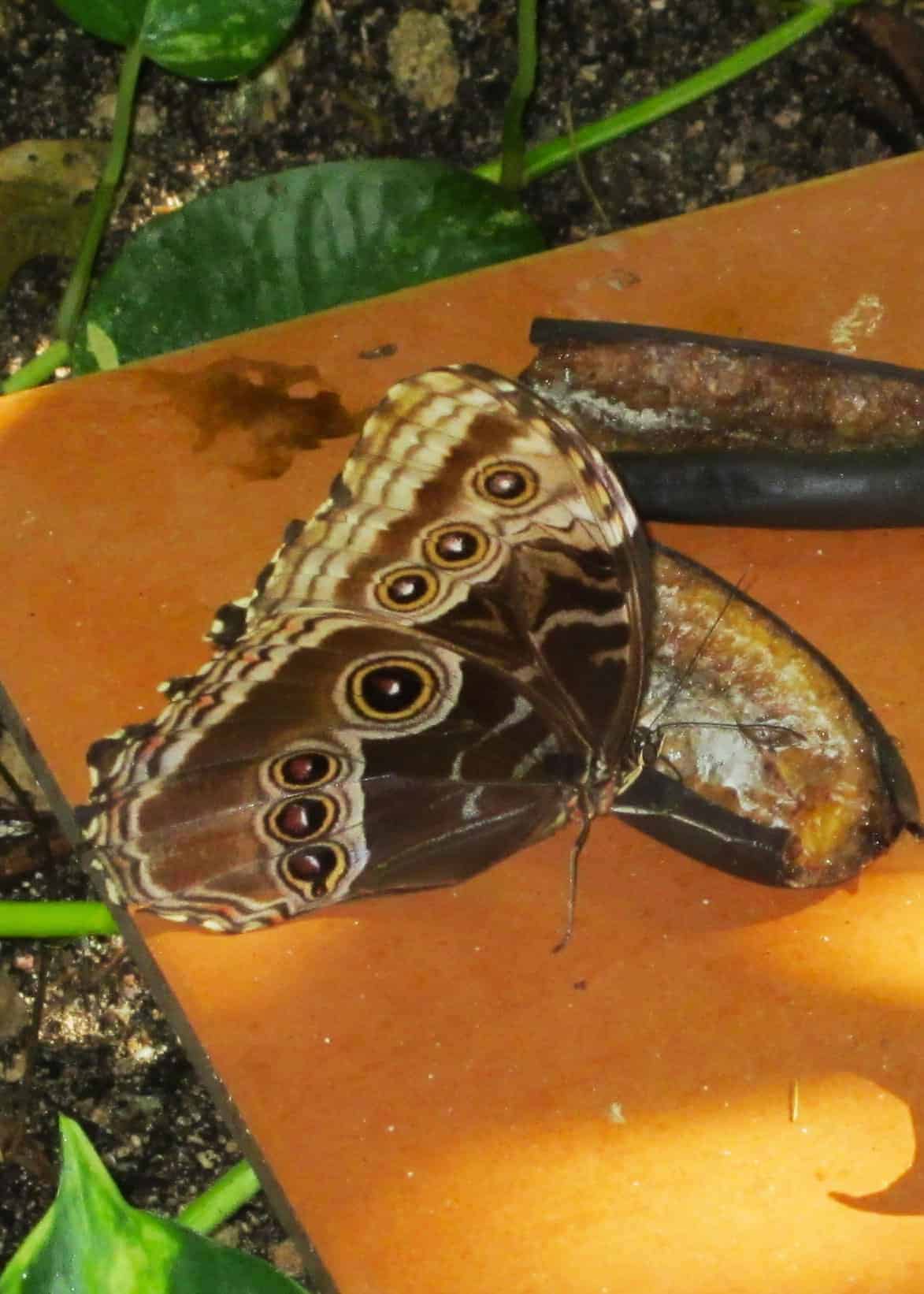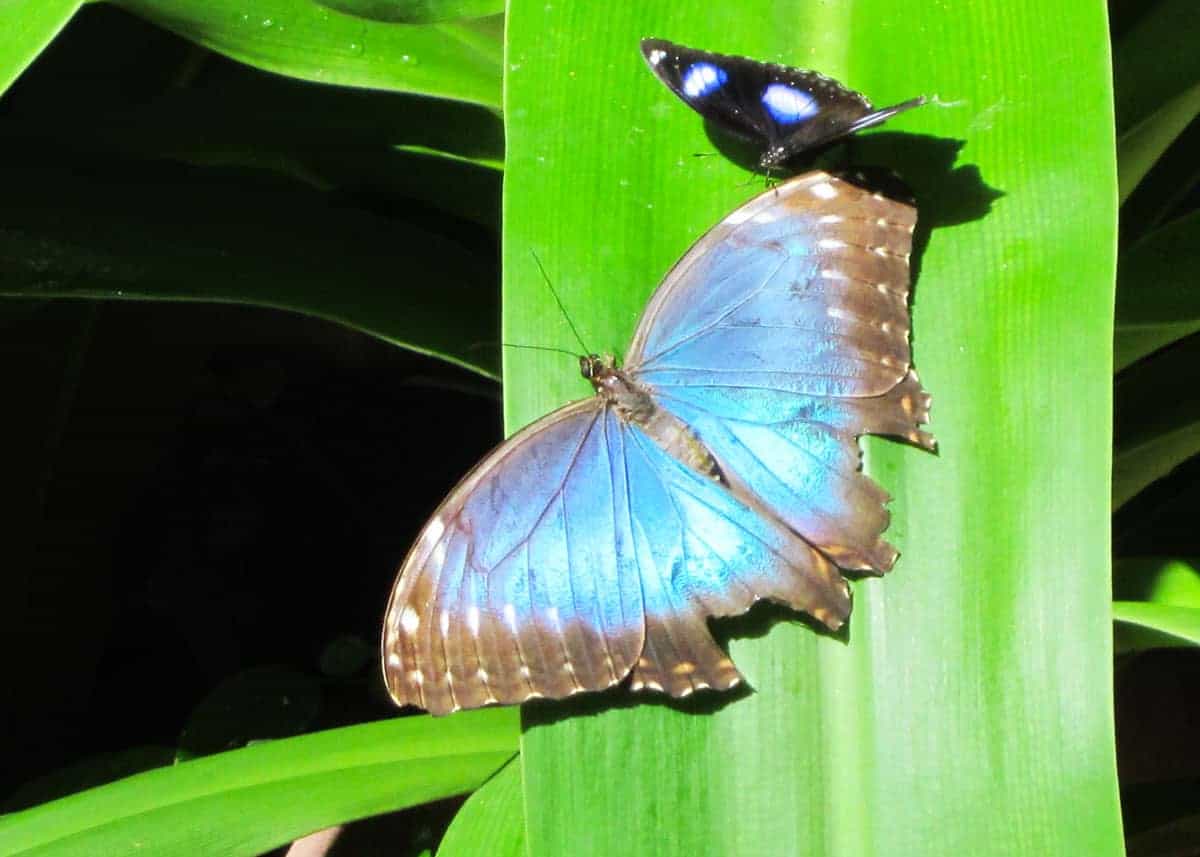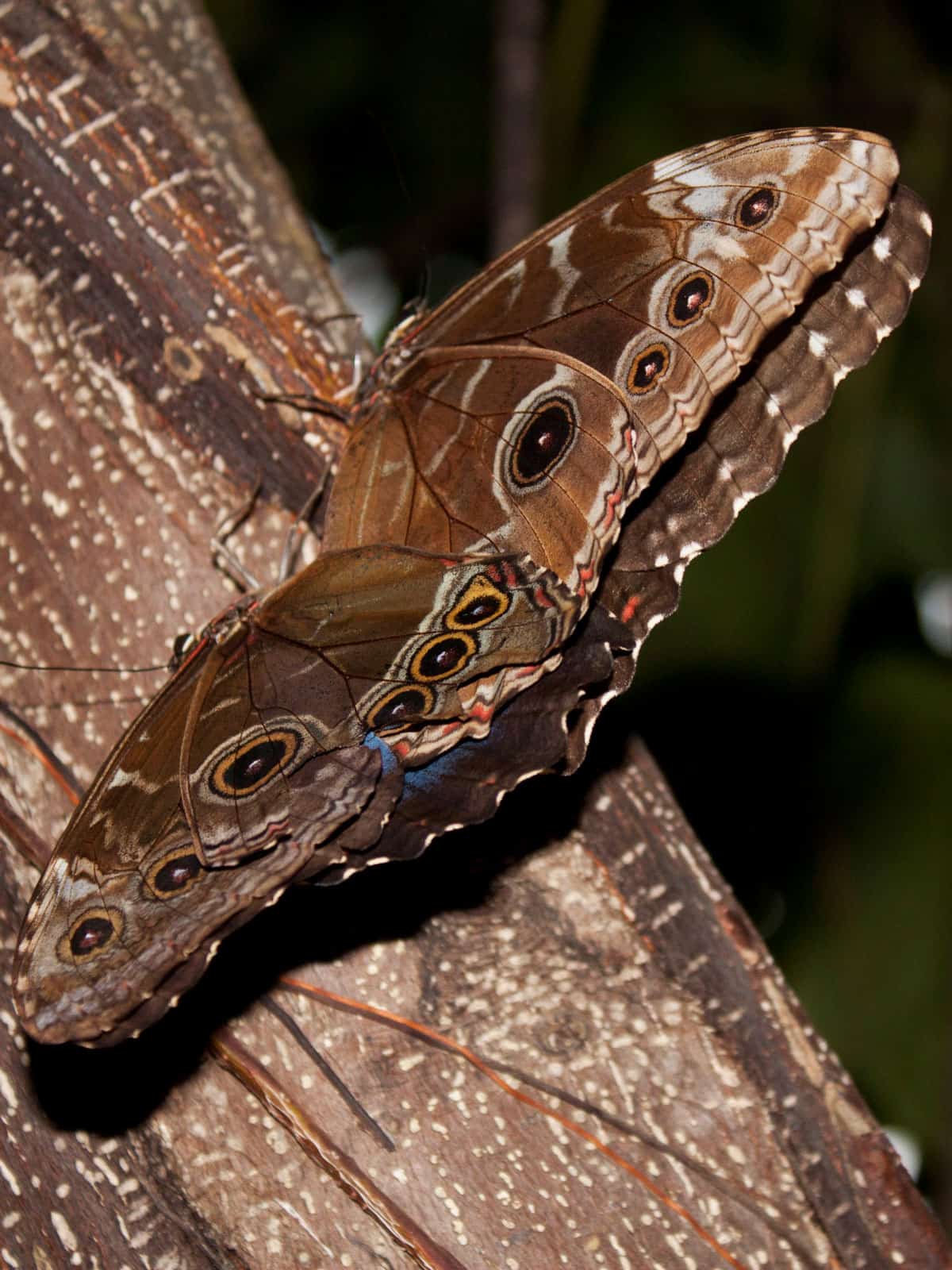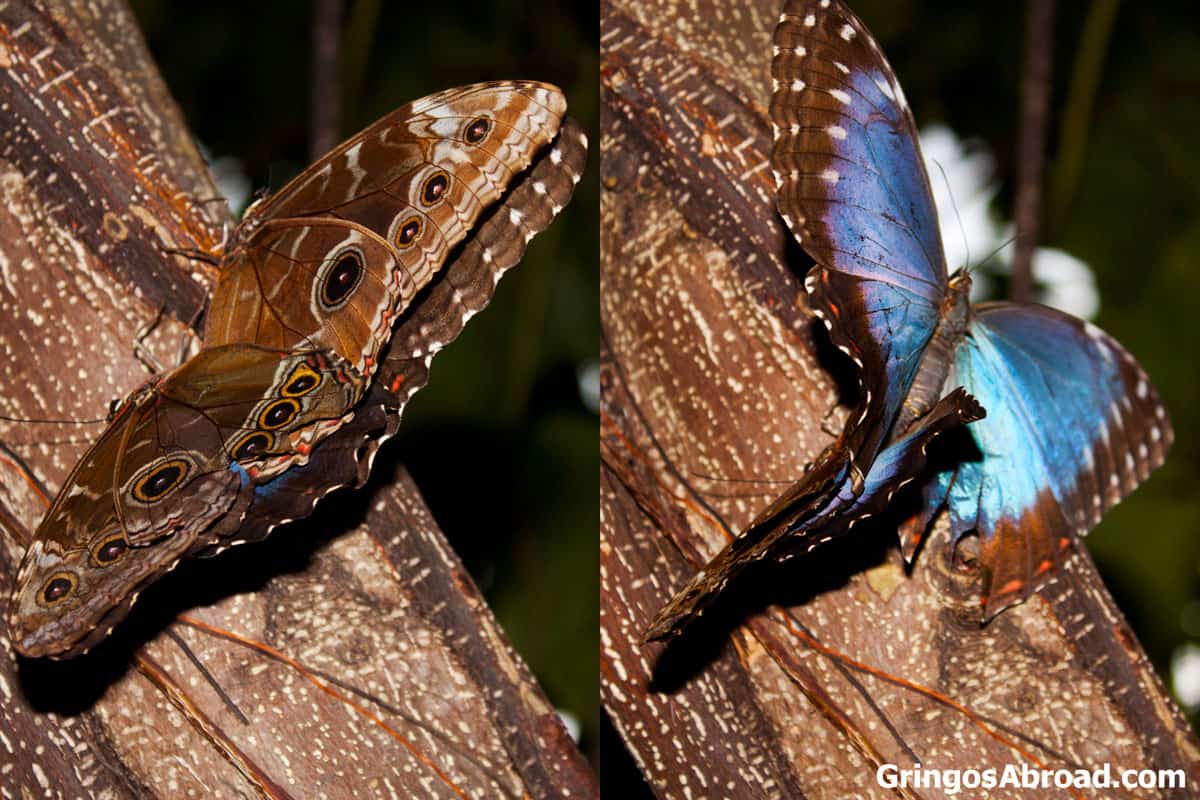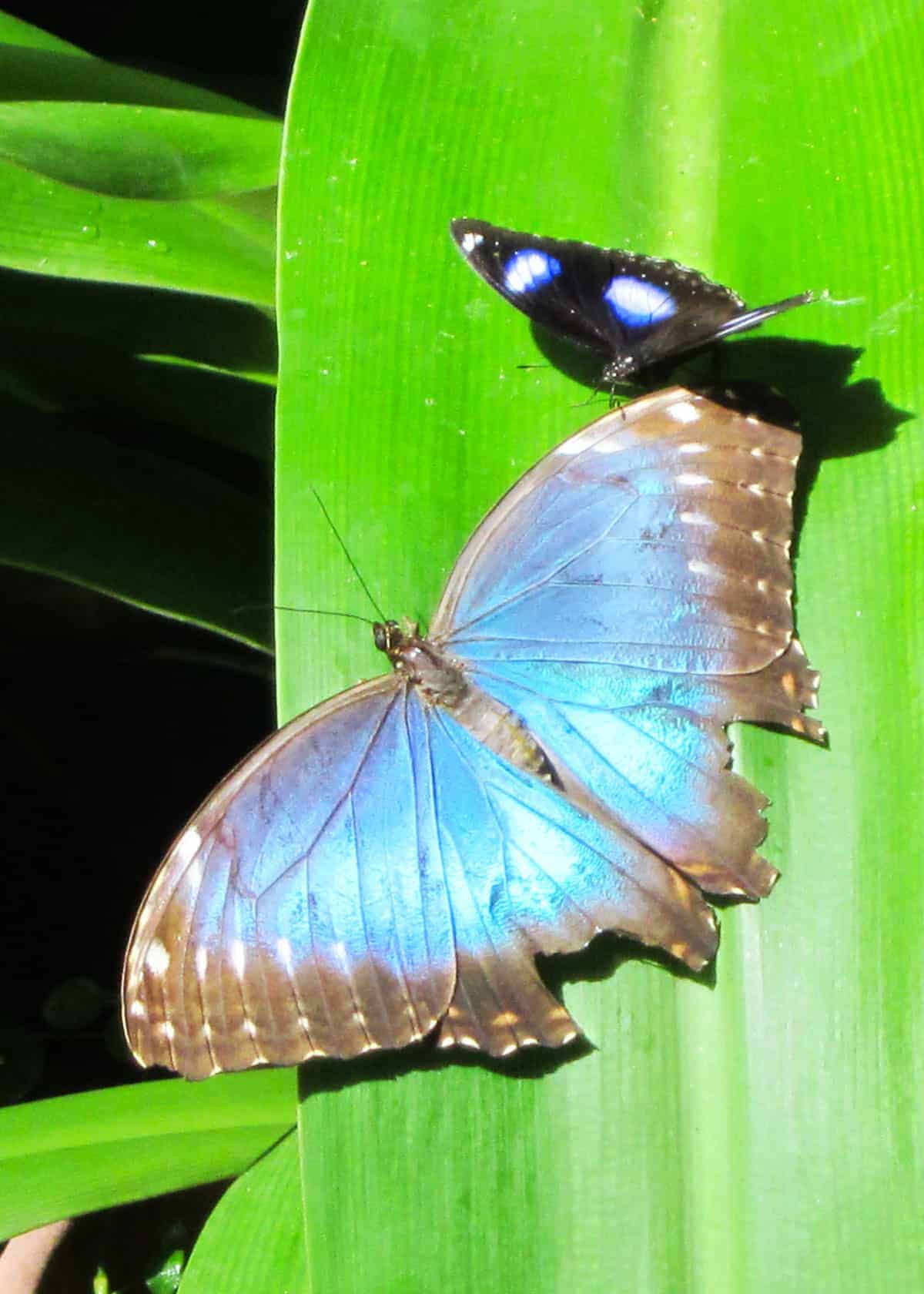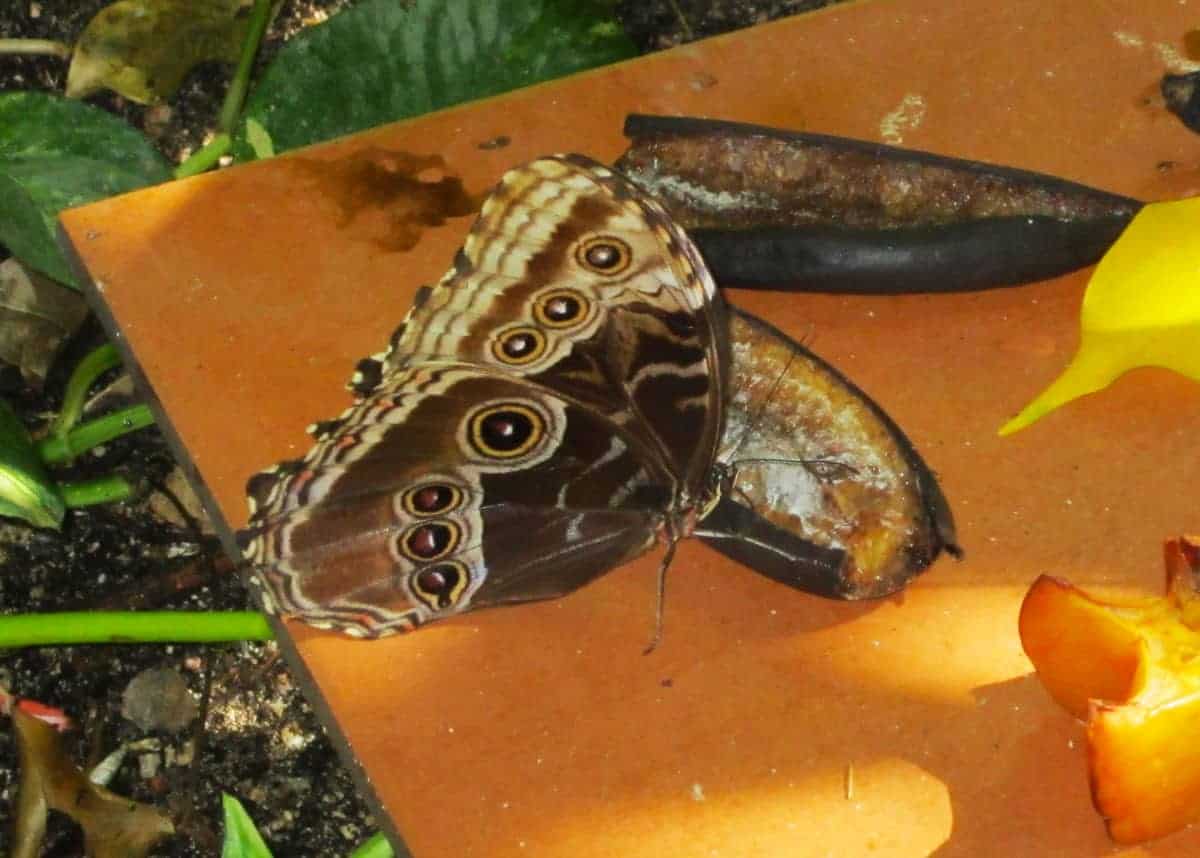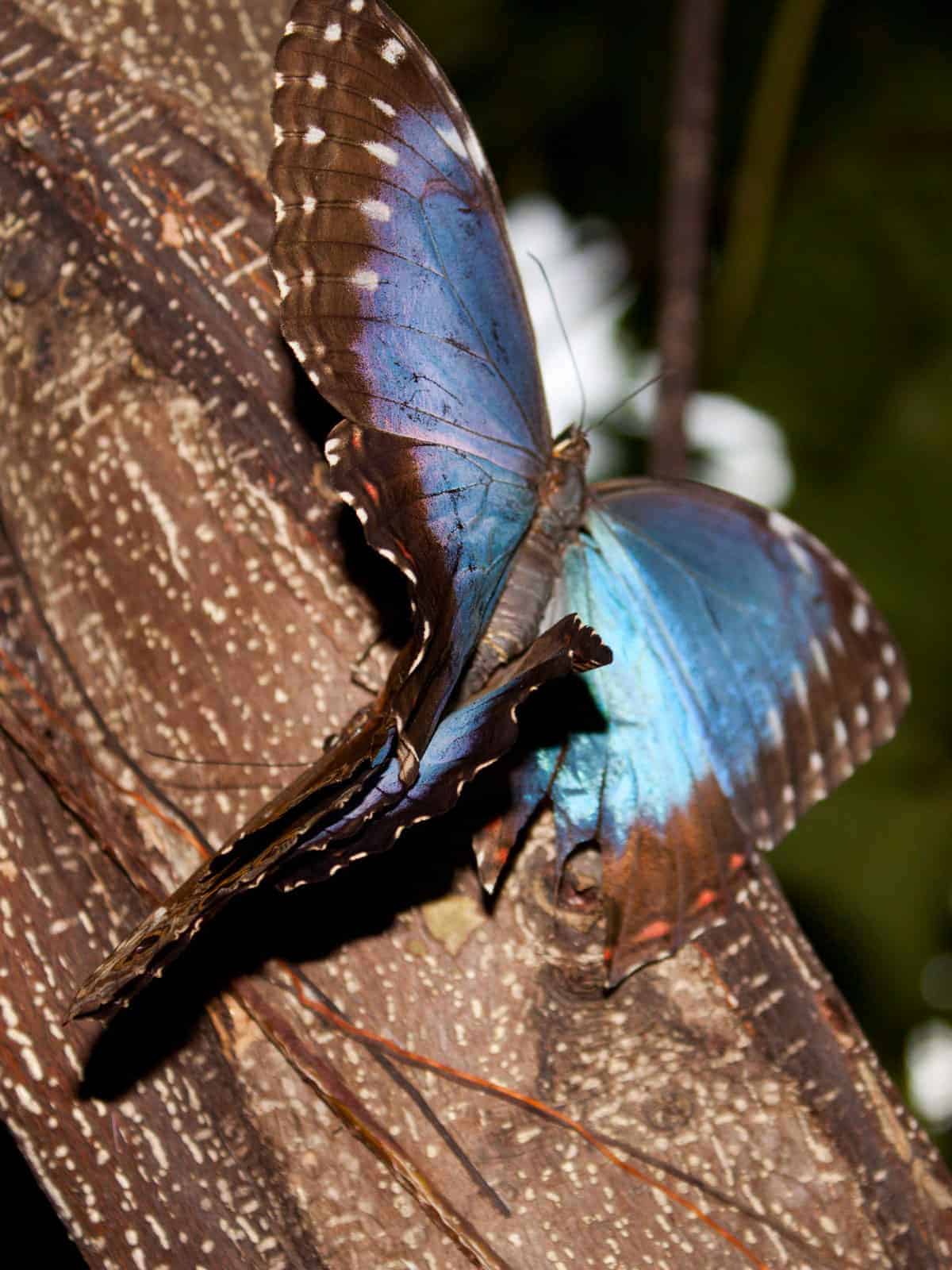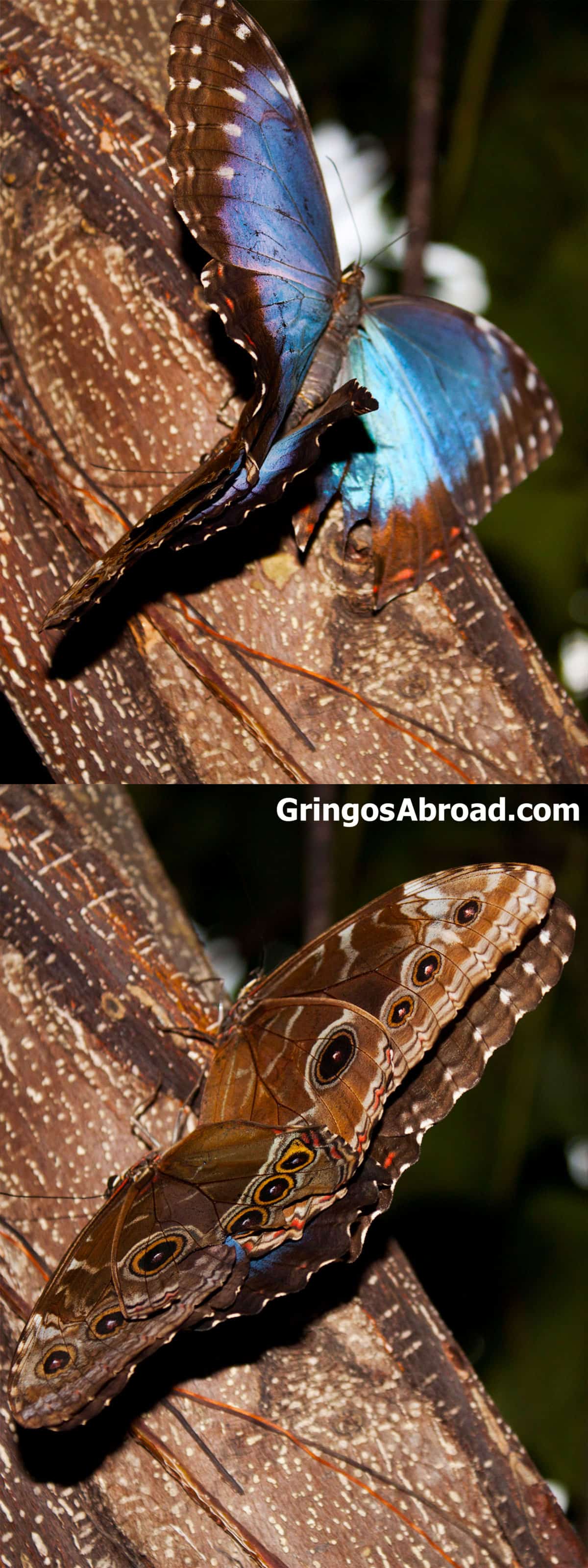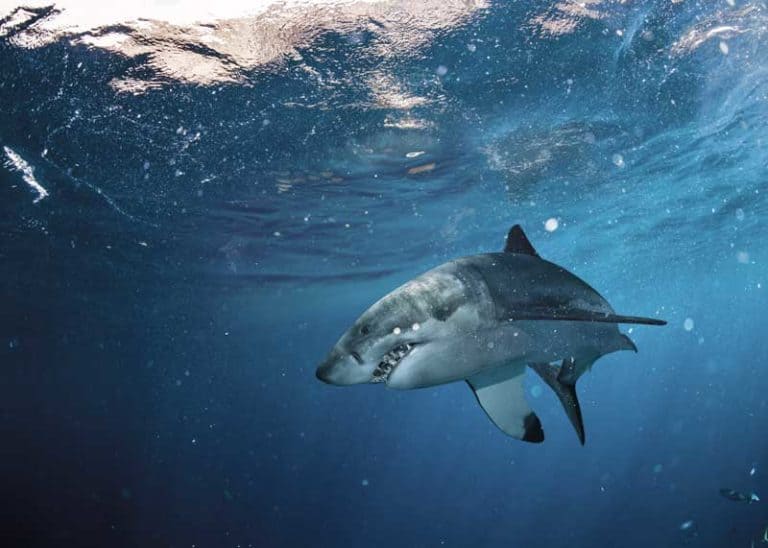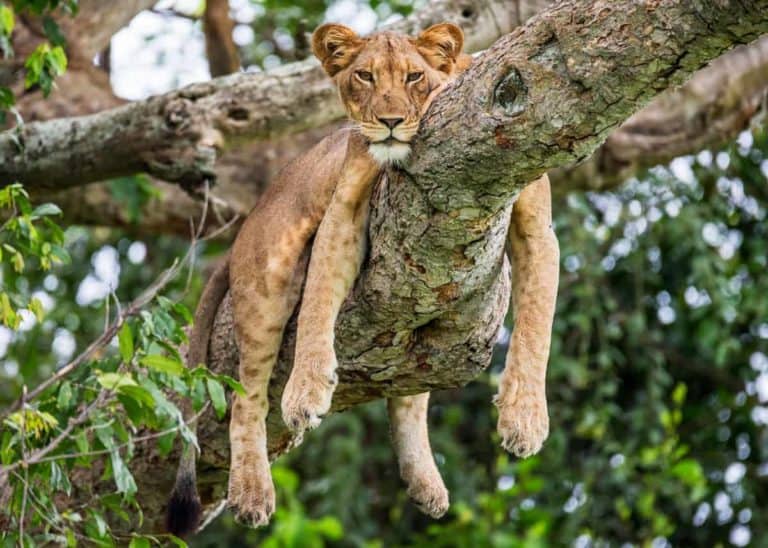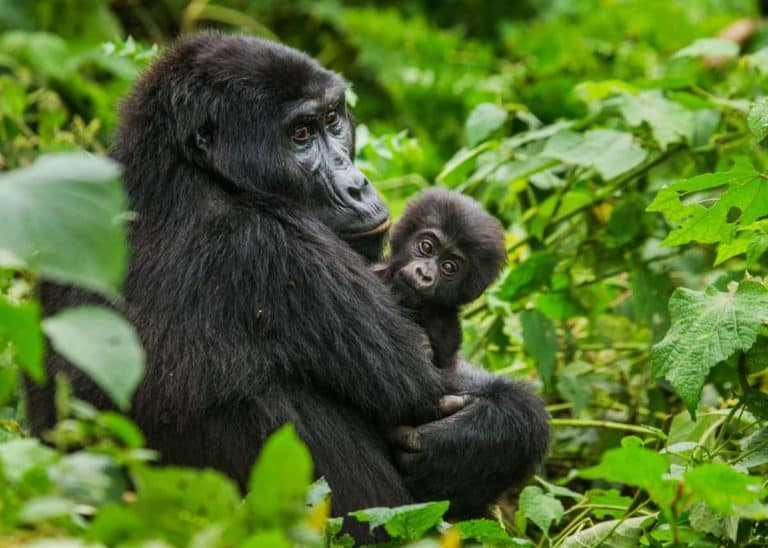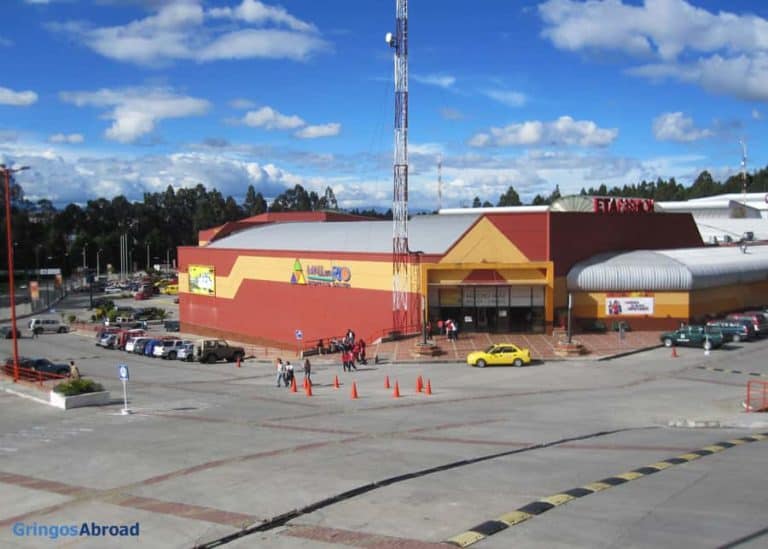15 Blue Morpho Butterfly Facts: Iridescent Gem of Ecuador’s Amazon (All 24 Species)
Planning a trip to Ecuador’s Amazon rainforest? Here are 15 amazing blue morpho butterfly facts that you’ll want to know before your trip!
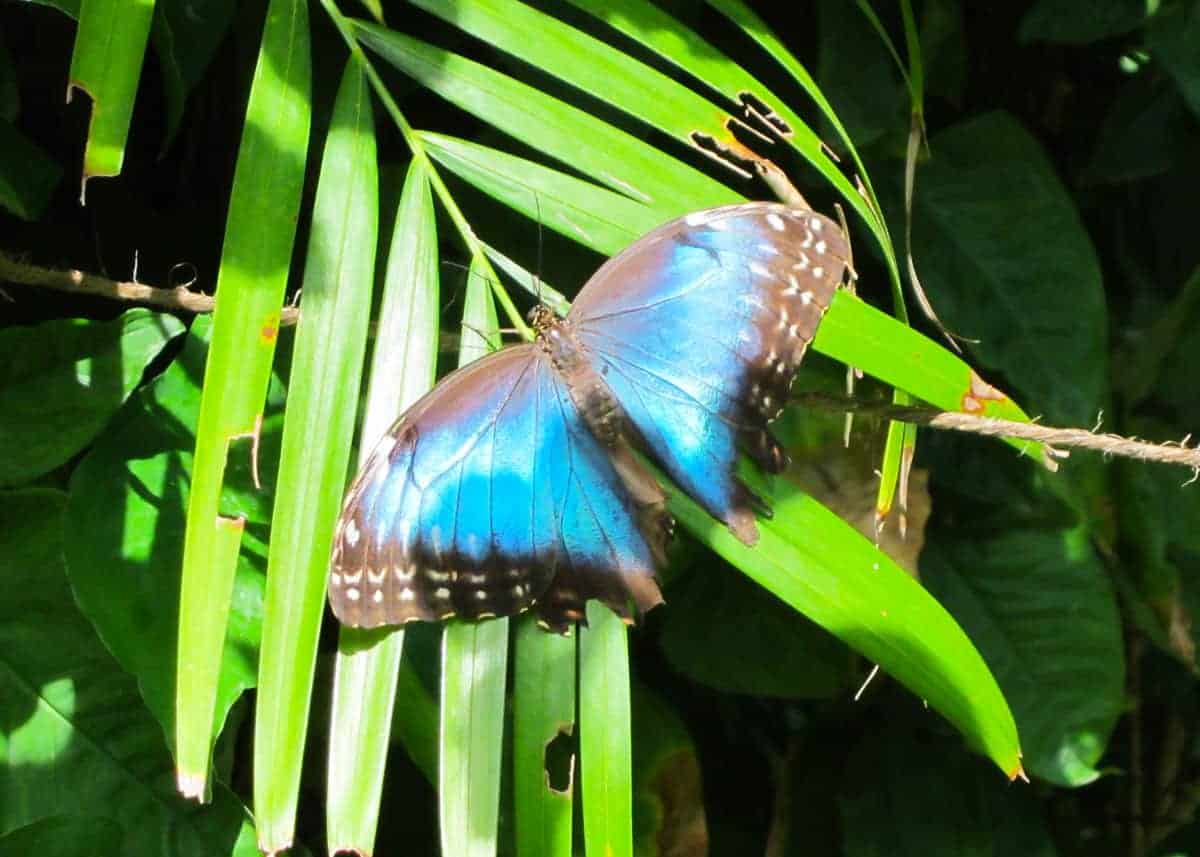
Blue morpho butterflies are famous for the striking blue of their wings. In this post, you’ll learn what gives them that incredible color, where and how long they live, and what they eat.
Where can you see blue morphos in Ecuador? While you can expect to see these in Ecuador’s Amazon jungle, we’ve also seen them in Guayaquil (on the Pacific side of the Andes). And other travelers have seen them in the Mindo Cloud Forest.
And here’s a little clickbait that will not disappoint:
- What makes the morpho butterfly blue? (jump to section)
- How many kinds of morpho butterflies are there? (jump to section)
- How big is a blue morpho butterfly? (jump to section)
- Are blue morpho butterflies endangered? (jump to section)
- What are the predators of a blue morpho butterfly? (jump to section)
- What blue morpho butterfly symbolize? (jump to section)
- How long does the blue morpho butterfly live? (Lifespan of blue morphos) (jump to section)
- Are blue morpho butterflies poisonous? (jump to section)
- What do blue morpho caterpillars eat? (jump to section)
- What do blue morphos butterflies eat? (jump to section)
- Can a blue morpho chew? (jump to section)
- Is a blue morpho butterfly a herbivore? (jump to section)
- Where do blue morphos live? (Habitat of blue morphos) (jump to section)
- Blue morpho butterfly: males vs. females (jump to section)
- Can gynandromorphism occur in blue morphos? (jump to section)
15 Blue Morpho Butterfly Facts: One of Ecuador’s Shining Gems
Blue morpho butterflies are simply amazing! The stunning blue of their wings is fascinating; in certain lights, you would think they weren’t blue at all. Did you know that these butterflies are poisonous? Read on to learn more about one of the world’s biggest butterflies.
1. What makes the morpho butterfly blue?
Did you know: Blue Morpho butterflies wings don’t contain any blue pigment. The brilliant blue is achieved by something called structural color, a way of producing color by taking advantage of the physics of light.
Pigment or Structural Color? Before we get into how structural color works, here’s a quick note to keep in mind:
- The brown, yellow, and black colors on the underside of the butterflies wings (shown when the butterfly is resting and has it’s two wings up together) are pigments.
- The blue color is structural color.
The butterflies wings are covered in tiny scales, which in turn are covered in itty-bitty ridges that look like evergreen trees. Put together, these scales and ridges work like a prism – refracting light.
Something called constructive interference occurs when the light hits the small ridges on the scales: the ridges reinforce the blue light while canceling out all the other colors, thus reflecting a beautiful, brilliant blue!
True blue pigment rarely occurs in nature – something that fascinates me because I have blue eyes. Or do I? In fact, my eyes aren’t actually blue at all. They are just perceived to be. The blue color of my eyes is produced in a very similar way that the blue morpho butterflies produce their blue color; structural color.
So do you have something in common with the blue morpho butterfly? Are your eyes blue? Let us know in the comments. Wait, wait! Finish reading our post first :).
2. How many kinds of morpho butterflies are there?
There are 39 kinds of morpho butterflies. Not all morphos are blue, many are green, and some rare ones are even white with a purple shine!
Below are the 39 kinds of morpho butterflies – it’s fairly boring. :’D
Ecuador’s 15 Types of Morpho Butterflies
Here are the 15 morpho butterfly types that live in Ecuador alphabetically along with the other places where they are found:
- Morpho achilles – Ecuador, Argentina, Bolivia, Brazil, Colombia, Paraguay, Peru, Suriname, and Venezuela
- Morpho amathonte – Ecuador, Colombia, Costa Rica, Panama, and Venezuela
- Morpho cisseis – Ecuador, Bolivia, Brazil, Colombia, and Peru
- Morpho cypris – Ecuador, Colombia, Costa Rica, Nicaragua, and Trinidad and Tobago
- Morpho deidamia – Ecuador, Bolivia, Brazil, Colombia, Costa Rica, Nicaragua, Panama, Peru, and Suriname
- Morpho granadensis – Ecuador, Colombia, Nicaragua, Panama, and Venezuela
- Morpho helena – northern South America
- Morpho helenor – Ecuador, Argentina, Bolivia, Brazil, Colombia, Costa Rica, El Salvador, French Guiana, Guatemala, Honduras, Mexico, Nicaragua, Panama, Paraguay, Peru, Suriname, Trinidad and Tobago, and Venezuela
- Morpho marcus – Ecuador, Brazil, Colombia, French Guiana, Peru, Suriname
- Morpho peleides – Mexico, Paraguay, Trinidad, nothern South America, and Central America
- Morpho rhetenor – Ecuador, Brazil, Colombia, French Guiana, Peru, Suriname, and Venezuela
- Morpho sulkowskyi – Ecuador, Colombia, and Peru
- Morpho telemachus – Ecuador, Bolivia, Brazil, Colombia, French Guiana, Guyana, Peru, Suriname, and Venezuela
- Morpho theseus – Ecuador, Colombia, Costa Rica, Guatemala, Honduras, Mexico, Panama, and Venezuela
- Morpho uraneis – Ecuador and Brazil
And here are the other 24 types of morpho butterflies alphabetically along with where they are found:
- Morpho absoloni – Brazil and Peru
- Morpho aega – Argentina, Brazil, and Paraguay
- Morpho amphitryon – Bolivia and Peru
- Morpho anaxibia – Brazil
- Morpho athena – Brazil
- Morpho aurora – Bolivia and Peru
- Morpho catenarius – Brazil
- Morpho didius – Peru
- Morpho epistrophus – Argentina, Brazil, Paraguay, and Uruguay
- Morpho eugenia – French Guiana
- Morpho godarti – Bolivia and Peru
- Morpho hecuba – the Guianas
- Morpho hercules – Brazil and Paraguay
- Morpho laertes – Neotropical
- Morpho luna – Neotropical
- Morpho lympharis – Peru and Boliva
- Morpho menelaus – Brazil, Mexico, and Venezuela (as well as south and central america)
- Morpho niepelti – Colombia, exclusivly
- Morpho polyphemus – Central America, Costa Rica, and Mexico
- Morpho portis – Brazil, Colombia, Paraguay, Peru, Uraguay, and Paraguay
- Morpho rhodopteron – Colombia (Sierra Nevada de Santa Marta), exclusivly
- Morpho richardus – Brazil (Minas Gerais), exclusivly
- Morpho thamyris – Brazil and Paraguay
- Morpho zephyritis – Boliva and Peru
3. How big is a blue morpho butterfly?
Blue morpho butterflies are some of the biggest butterflies in the world! They have a wingspan of up to 8 in (20 cm); that is the standard width of a piece of printer paper, so it is pretty amazing to see one – especially when it lands on your arm.
4. Are blue morpho butterflies endangered?
No, not directly. But blue morphos face many threats, such as deforestation and collectors who capture and kill them to make jewelry out of their wings.
5. What are the predators of the blue morpho butterfly?
Birds, like flycatchers and jacamars, and humans. Birds eat the butterflies, and humans collect them. And because we are such a civilized society, very few people keep live collections. No… we just poison them and make jewelry out of them. Not the best way to show our appreciation for nature, huh?
Of course, there are ways for this to be done humanely. For example, if you worked at a butterfly farm, and one of the morphos was to die (considering they only live around 3 months, very likely) and you were then to make jewelry out of its wings. You would likely need permission from the owner of the farm, but using the butterflies this way after they are dead is much different than killing them, in my opinion.
So if you are looking for butterfly wing art or jewelry, you may want to do some research on the seller on how and where they get their butterfly wings.
6. What does the blue morpho butterfly symbolize?
Blue butterflies, in general, have a very debated meaning; some people believe they grant wishes – others that they are wicked spirits. They are also thought to symbolize joy and happiness, as well as bring instant good luck.
Whatever you choose to believe, seeing a blue morpho will certainly bring you joy and happiness.
7. How long does the blue morpho butterfly live? (Lifespan of blue morphos)
Roughly, 3 months from egg to butterfly.
Here’s what happens:
Blue morphos start their lives as small (1-2 mm), smooth, semi-transparent, light green, brown-spotted eggs laid on the underside of leaves. The eggs can change color to protect themselves from predators, from a yellowish green to white to brown. They are in the eggs for up to 16 days, and the egg changes color again before they hatch: it is now a brownish black color.
After the eggs hatch, the caterpillars don’t look much like “blue” morphos at all – they are a reddish brown with greenish yellow spots and tufts of hair/fur which ranges in color from a pinkish white to a deep rust color. The blue morpho lives as a caterpillar/larva for about 8 weeks before the chrysalis (a.k.a cocoon) forms and the morpho enters the pupae stage. When it is about to enter the chrysalis stage, the color of the caterpillar changes to a light green and the tufts of hair a much smaller and white.
The chrysalis stage lasts about two weeks depending on the environment. The chrysalis (cocoon) is a light frosted green – the same color the caterpillar was when the chrysalis formed. When the blue morpho butterfly is ready to hatch from the chrysalis, the butterfly pulses over and over and eases its chrysalis open and squeezes out.
At first, the body is quite large, and the wings are rather small and wrinkly. The first thing the newly hatched butterfly does is have a big pee; I mean, they’ve been holding it for 2 weeks! This decreases their body size somewhat. After they’ve had a good pee, they begin to pump blood from their fat little bodies into their limp wings. Over roughly 20 minutes, the wings will expand dramatically.
After the adult blue morpho butterfly emerges from the chrysalis (cocoon), it has only 2-3 weeks to mate and lay eggs. Then the process starts all over again.
Cue the fascinating video 🙂
8. Are blue morpho butterflies poisonous?
Yes. As caterpillars, the leaves they feed on contained a poisonous compound which then makes them toxic to predators as adults. Check out the next point to learn what they eat!
While you might get sick if you ate one, just holding a morpho butterfly won’t hurt you. However, be very careful not to touch the wings as you could knock off some of the scales, which the butterfly cannot regenerate! If you were to hold a blue morpho caterpillar, the tufts of hair would likely irritate your skin like tiny spines.
9. What do blue morpho caterpillars eat?
Plant leaves, specifically those from the pea family. Many varieties of the Fabaceae family (pea plants) have poisonous leaves that can be deadly to mammals.
Because the caterpillars eat these, they then become poisonous to predators as adult butterflies.
10. What do blue morphos eat? (Diet)
Decomposing fruit, sap, mud, fungi, and even decomposing animals.
Pictured below is a small feeding station with bananas, oranges, and starfruit. It attracted many butterflies, including the blue morpho.
11. Can a blue morpho chew?
Not really. At this stage, they only consume liquid food.
Adult blue morpho butterflies can’t chew their food as they could as caterpillar/larvae. Instead, they use their long proboscis (straw-like mouthpart) to drink their food – which is why it all has to be liquid.
12. Is a morpho butterfly a herbivore?
Not really, but mostly. “Yeah, thanks. That clears everything up.” Alright, alright. Stay with me for a minute. Blue morphos mainly feeds on fruit juices and sap, but it will also drink juices of decomposing animals, so it can’t be called a true herbivore.
13. Where do blue morphos live? (Habitat of blue morphos)
All morpho butterflies are neotropical, which means that they live in Mexico and Central and South America. Check #2 for a break down of where all 39 kinds of morphos live!
In Ecuador, watch for blue morphos on the Pacific coast and the Amazon jungle.
14. Blue morpho butterfly: males vs. females (What’s the difference?)
In all morpho species, only the males are all blue. Depending on the species, female morphos range in color from brown and yellow to partial iridescent blue (but notably less than the males).
15. Can gynandromorphism occur in blue morphos?
Gynandromorphism occasionally occurs in blue morpho butterflies – with varying levels of gender mixture. This can be either bilateral (split down the middle) mosaic (patches appearing of each gender appearing among characteristics of the other). Gynandromorphs appearance can vary greatly.
More reading: 47 Amazon Rainforest Animals
Shining Gem of the Amazon
That’s it for now; I hope you enjoyed our 12 blue morpho butterfly facts! Ecuador is full of amazing animals, all you have to do is look for them. For me, knowing something about the animals before I see them really enhances the experience. It makes them that much more fascinating.
Do you have a favorite fact? Is there something you would like to know? Is there an Ecuador animal you would like to know more about? Go ahead and tell us in the comments, we love to hear from you!
Enjoyed this article? Check out some more by this author: 46 Weird Ecuador Facts and 14 Frigatebird Facts

